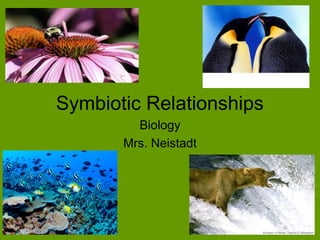
Ecology: Symbiotic Relationships
- 1. Symbiotic Relationships Biology Mrs. Neistadt
- 2. *Species Interactions • *Species within a community develop close interactions, known as symbiosis. – “Sym” means together – “Bio” means life – Symbiosis means “living together” and describes the close relationships developed between species. • *Symbiotic relationships will always benefit at least one organism involved.
- 3. Species Interactions • *There are 5 major types of symbiotic relationships: – *Predation – *Parasitism – *Competition – *Mutualism – *Commensalism
- 4. *Predation • *Predation is a relationship where one organism captures and consumes another. – Predator – organism doing the capturing – Prey – organism being captured • A predator’s survival depends on its ability to catch its prey. – Ex: rattlesnake venom, spider web, etc. • A prey’s survival depends on its ability to avoid being caught. – Camouflage, mimicry, physical/chemical defenses
- 5. *Prey Defenses • *Mimicry – a defense where one organism resembles another that is dangerous or poisonous • There are two types of mimicry: – A harmless organism closely resembles a dangerous one • Known as Batesian mimicry • Predators learn to avoid both species • Ex: King snake and coral snake – Two harmful organisms resemble one another • Known as Mullerian mimicry • Added advantage to their already harmful adaptations • Ex: Bees and wasps have similar striping
- 6. Prey Defenses • *Plants have also developed adaptations to protect them from predators. – Physical defenses make them difficult to eat • Ex: Spines, thorns, tough leaves – Can produce secondary compounds • Secondary compounds are synthesized from products of the plant’s metabolism • Usually poisonous, irritating, or bad-tasting • Ex: Poision ivy and poison oak
- 7. *Parasitism • *Parasitism – symbiotic relationship where one organism is harmed and the other is helped – Parasite feeds on the host organism – Unlike predation, it does not result in the immediate death of the host • Ex: tapeworms can live in human digestive tract for long periods of time
- 8. Parasitism • There are 2 different types of parasites: – Ectoparasites • External parasites – live on the outside of the host • Ex: ticks, fleas, mosquitoes – Endoparasites • Internal parasites – live inside the host’s body • Ex: bacteria, protists, tapeworms
- 9. *Competition • *Competition – the use of the same limited resource by two or more species in the same place at the same time – Resource = anything necessity of life (water, nutrients, light, food, or space) • Competition may cause the development of different niches or physical characteristics.
- 10. Competition • Competitive Exclusion Principle – No two species can occupy the same niche in the same habitat at the same time – Ex: Paramecia • Two species of paramecia will thrive separately, but when put together, one species is eliminated
- 11. *Competition • *Organisms may develop physical differences because of competition for resources. • Character Displacement – evolution of anatomical differences that reduces competition – Happens most where ranges of competitors overlap – Ex: Darwin’s finches • Species found in separate locations have the same beak size • The same species found together have different beak sizes – allows them to feed on different seeds and reduces competition
- 12. Competition • Organisms may develop differences in niches because of competition for resources. • Resource Partitioning – species coexist by using only part of the available resources – Ex: some birds eat the same insects, but hunt for them in different places
- 13. *Mutualism • *Mutualism is a symbiotic relationship where both organisms are helped in some way. • Ex: *Plants and their pollinators – Pollinators feed on the plants and pollen gets stuck to them. – Pollen is deposited on the next plant, allowing the plants to reproduce sexually.
- 14. *Commensalism • *Commensalism is a symbiotic relationship where one organism benefits and the second is neither harmed nor helped. • Ex: *Whales and Barnacles – Barnacles have the benefit of moving through waters attached to the whale – The whale receives no benefit, but is not harmed either
- 15. Name the Symbiotic Relationship… • A eagle hunting a mouse. – Predation • A tick feeds on the blood of its host and may carry disease – Parasitism • The flower lives on a tree and absorbs the water from runoff and the tree is unaffected. – Commensalism • Two different types of finches feeding on seeds. – Competition • An ant protects a caterpillar from predators and the caterpillar produces a sweet liquid for it to drink. – Mutualism
